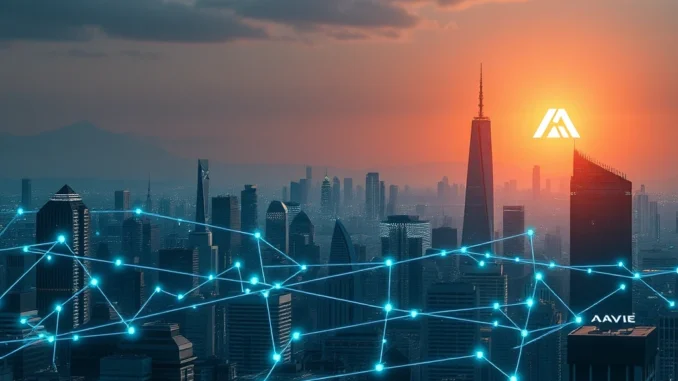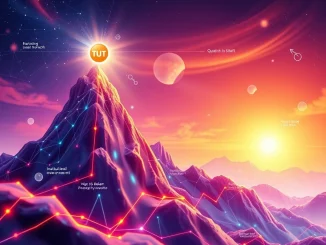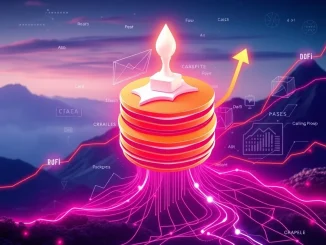
Exciting news for the DeFi enthusiasts! Aave Labs, the powerhouse behind the popular decentralized lending protocol Aave, is taking a bold leap into the future. Get ready for Horizon, an innovative proposal designed to bridge the gap between traditional finance and the decentralized world by integrating real-world assets (RWAs) into DeFi. This initiative could redefine how institutions interact with decentralized finance, paving the way for a new era of financial accessibility and efficiency.
What is Aave Horizon and Why is it a Game Changer for DeFi?
Horizon isn’t just another update; it’s a strategic proposal aimed at weaving real-world assets into the fabric of decentralized finance. Imagine institutions being able to leverage tokenized money market funds (MMFs) as collateral within DeFi. That’s precisely what Aave Labs envisions with Horizon. According to reports from BeInCrypto, this groundbreaking project is designed to operate within a regulated framework, ensuring compliance and security while unlocking unprecedented access to DeFi for institutional players.
Here’s a breakdown of why Horizon is making waves in the DeFi space:
- Bridging Traditional Finance and DeFi: Horizon directly addresses a major hurdle in DeFi adoption – institutional involvement. By allowing tokenized MMFs as collateral, it opens the doors for institutions to tap into DeFi liquidity using assets they are already familiar with.
- Enhanced Institutional Access: For institutions hesitant to dive into the complexities of crypto-native assets, Horizon offers a comfortable entry point. Using tokenized MMFs reduces the learning curve and perceived risk, making institutional DeFi participation more appealing.
- Regulated Framework: Operating as a licensed instance of Aave V3, Horizon prioritizes regulatory compliance. This is crucial for attracting institutional capital, as regulatory clarity is often a prerequisite for large-scale adoption.
- Revenue Sharing for Aave DAO: The proposal includes a significant 50% revenue share for the Aave DAO in its first year, demonstrating a commitment to the Aave community and the long-term sustainability of the ecosystem. Furthermore, a potential 15% token allocation to the DAO treasury could further strengthen community governance and development.
- Future-Proofing with Aave V4 Transition: Starting on Aave V3 and planning a transition to Aave V4 shows foresight and adaptability. This ensures that Horizon will benefit from the latest advancements in Aave’s technology, staying at the cutting edge of DeFi innovation.
How Will Aave Horizon Actually Work?
The core concept of Horizon revolves around using tokenized money market funds as collateral. But let’s break down how this will likely function and what it means for the DeFi landscape.
Imagine a large financial institution holds substantial assets in traditional money market funds. Through Horizon, they could tokenize these MMFs, essentially creating a digital representation of these assets on the blockchain. These tokenized MMFs can then be used as collateral within the Horizon instance of Aave V3 to borrow stablecoins. This stablecoin liquidity can then be utilized for various purposes, potentially including further DeFi investments or traditional financial operations.
Here’s a simplified view of the process:
- Tokenization of Money Market Funds: Institutions tokenize their holdings in regulated money market funds. This process creates a digital token representing the real-world asset.
- Collateralization on Aave Horizon: These tokenized MMFs are deposited as collateral into the Horizon platform, a licensed instance of Aave V3.
- Stablecoin Borrowing: Using the tokenized MMFs as collateral, institutions can borrow stablecoins, gaining access to DeFi liquidity.
- Liquidity Utilization: The borrowed stablecoins can be used for various strategies within DeFi or even bridged back to traditional financial systems as needed.
This mechanism is designed to be a win-win. Institutions gain access to the innovative world of DeFi without drastically altering their existing asset management strategies, and the DeFi ecosystem benefits from a significant influx of institutional capital and real-world assets.
The Benefits of Integrating Real-World Assets into DeFi
Integrating real-world assets into DeFi, as proposed by Aave Horizon, is not just a technical upgrade; it’s a fundamental evolution with numerous potential benefits:
- Increased Liquidity in DeFi: Injecting RWAs into DeFi can significantly boost the overall liquidity within decentralized protocols. This increased liquidity can lead to more efficient markets, reduced slippage, and better yields for participants.
- Wider Adoption of DeFi: By making DeFi more accessible and appealing to institutions, Horizon can accelerate the mainstream adoption of decentralized finance. Institutional involvement is crucial for DeFi to reach its full potential and challenge traditional financial paradigms.
- Diversification of Collateral Types: Currently, DeFi is heavily reliant on crypto-native assets as collateral. Introducing RWAs diversifies the types of collateral available, potentially reducing systemic risks and making the ecosystem more robust.
- New Use Cases for Tokenized Assets: Horizon opens up new avenues for the utility of tokenized assets. Tokenized stocks, bonds, real estate, and commodities could all potentially find a place within DeFi, creating a more interconnected and versatile financial ecosystem.
- Enhanced Yield Opportunities: The integration of RWAs could lead to the creation of novel yield-generating strategies within DeFi. By combining the stability of traditional assets with the innovative mechanisms of DeFi, new and attractive yield opportunities may emerge.
Potential Challenges and Considerations
While the Horizon proposal is incredibly promising, it’s important to acknowledge potential challenges and considerations:
- Regulatory Hurdles: Navigating the regulatory landscape for RWAs in DeFi is complex and varies across jurisdictions. Ensuring full compliance and obtaining necessary licenses will be crucial for Horizon’s success.
- Custodial Risks: Tokenizing real-world assets often involves custodial solutions. Maintaining the security and integrity of these custodial arrangements is paramount to prevent risks associated with traditional asset management.
- Valuation and Oracle Dependency: Accurately valuing RWAs and reliably feeding this information into DeFi protocols via oracles is essential. Any inaccuracies or vulnerabilities in oracle systems could pose risks to the platform.
- Adoption by Institutions: While Horizon aims to attract institutions, their actual adoption rate will depend on various factors, including their internal risk assessments, regulatory clarity, and the perceived benefits of participating in DeFi.
- Transition to Aave V4: Successfully transitioning Horizon from Aave V3 to V4 will require careful planning and execution to ensure a seamless and secure upgrade without disrupting operations.
A Glimpse into the Future of DeFi with Real-World Assets
Aave Horizon represents a significant step forward in the evolution of decentralized finance. By strategically integrating real-world assets within a regulated framework, Aave Labs is not just expanding the capabilities of its protocol; it’s actively shaping the future of finance. If approved by the Aave DAO, Horizon has the potential to unlock a new wave of institutional participation in DeFi, driving innovation, increasing liquidity, and ultimately bringing decentralized finance closer to the mainstream.
The proposal’s focus on revenue sharing and DAO governance further underscores Aave’s commitment to community-driven growth and decentralization. As Horizon progresses, it will be fascinating to witness its impact on the DeFi landscape and how it paves the way for even more sophisticated integrations of traditional and decentralized finance.
Keep an eye on the Aave DAO governance proposals for updates on Horizon – this could be a pivotal moment for institutional DeFi and the broader crypto ecosystem!



